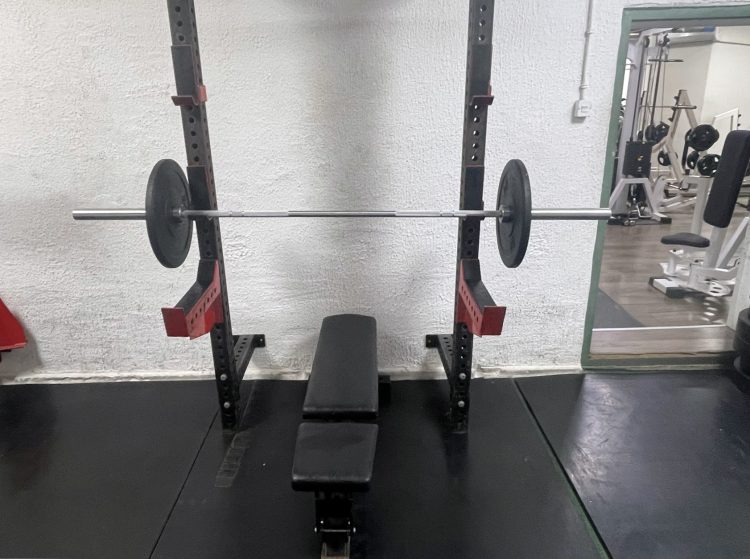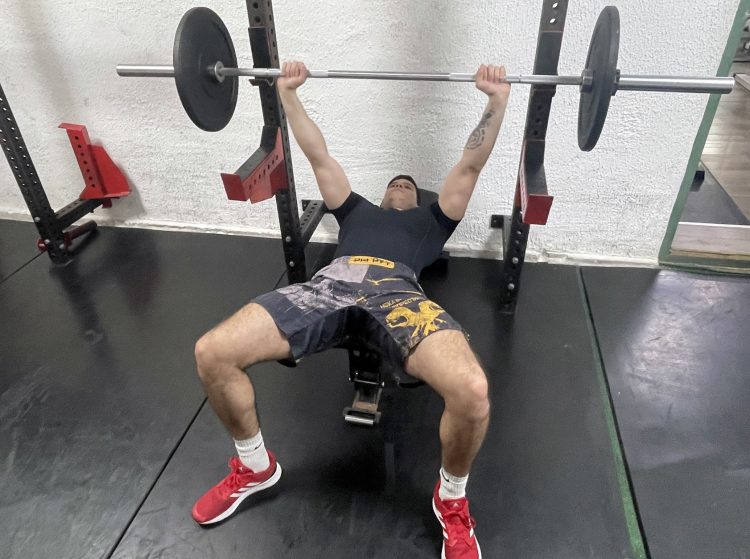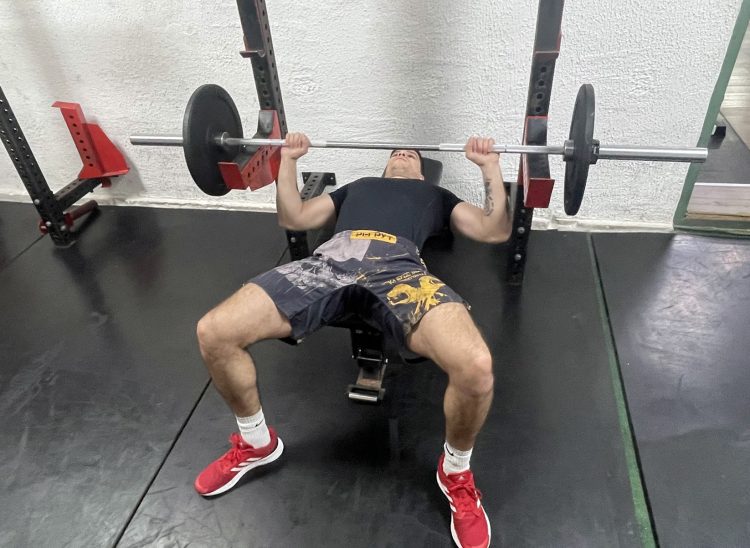The pin bench press is an excellent exercise for overloading the chest and triceps and building lockout strength. The top half of the bench press range of motion (ROM) mainly works the triceps. However, you can shift the bias to the chest using a wider-than-shoulder-width grip.
However, the advantages of the pin bench press extend beyond targeted chest and triceps development. It can also benefit combat sports athletes like mixed martial artists by improving punching power.
This detailed pin bench press guide covers everything, including how to pick the right pin height and grip width to maximize target muscle stimulation.
How To Do a Pin Bench Press
Here is how to do a pin bench press properly:
Step One — Set the Proper Pin Height and Rack the Bar
Set a flat bench inside a power rack. Adjust the safety pins to align roughly with your elbow height when lying on the bench. Alternatively, you can use spotter arms if you are using a squat stand or a half rack. Place a loaded barbell on the pins.
Level Up Your Fitness: Join our 💪 strong community in Fitness Volt Newsletter. Get daily inspiration, expert-backed workouts, nutrition tips, the latest in strength sports, and the support you need to reach your goals. Subscribe for free!
Pro Tip: Experiment with different pin heights until you’re satisfied with the target muscle stimulation. This is vital for hypertrophy and strength development.
Step Two — Unrack the Barbell
Grab the barbell with a shoulder-wide overhand grip, lift it off the pins, and hold it in line with your chest. With your feet planted on the floor, brace your core and explosively extend your elbows.
Pro Tip: Since this bench press variation allows you to overload the chest and triceps, stability becomes even more important. Place your feet wider than shoulder-width apart for extra stability.
Step Three — Lower the Barbell to the Pins
Slowly reverse the motion to lower the barbell to the pins. There should be no tension on your triceps and chest at the bottom of the range of motion (ROM).
Repeat for the recommended repetitions.
Pro Tip: Use slow eccentrics (2-3 seconds) to maximize tricep and chest activation. To develop explosive strength, push the barbell as forcefully as possible. This will fire up the upper body fast-twitch muscle fibers, which are crucial for generating pushing strength.
How To Program the Pin Bench Press
Since the primary goal of this exercise is to develop a bigger and stronger chest and triceps, advanced lifters must work close to their 1RM. However, as with everything else in life, there is more than one viable approach.
Here is how I program the pin bench press for my personal training clients, prioritizing strength and hypertrophy:
| Strength | Hypertrophy | |
| Sets | 3-6 | 3-5 |
| Reps | 1-5 reps | 8-12 reps |
| Rest intervals | 2-5 minutes | 30-90 seconds |
| % of 1RM | >85% | 60-80% |
| Training frequency | 1-2 workouts per week | 1-2 workouts per week |
Pro Tip: Feel free to tweak the programming according to your experience, fitness level, and training objectives. Consider the principle of super-compensation, which depends on your nutrition, rest, and recovery. (1)
What is the Ideal Grip Width for Pin Bench Presses?
The ideal grip width for pin bench presses will primarily depend on your goals. A wider grip biases the chest, whereas a narrow grip targets the triceps.
For optimal triceps development, grasp the bar narrower than shoulder width. Conversely, widen your grip beyond shoulder width to target the chest.
Pin Press to Bench Press Ratio
The pin press to bench press ratio depends on several factors, including age, gender, experience and fitness levels, grip width, and the height of the pins.
However, if I needed to give some general guidelines for a broad population of lifers, I would say that you should, in theory, be able to lift 1.2 to 1.5 times your regular bench press weight on the pin press.
Remember, set the pins at the midpoint of your regular bench ROM.
Pin Bench Press Muscles Worked
The primary muscles working are the pectoralis major and triceps brachii.
The secondary muscles working include the anterior deltoids, serratus anterior, and latissimus dorsi.
Benefits of the Pin Bench Press
Here are the most notable benefits of performing pin bench presses:
Level Up Your Fitness: Join our 💪 strong community in Fitness Volt Newsletter. Get daily inspiration, expert-backed workouts, nutrition tips, the latest in strength sports, and the support you need to reach your goals. Subscribe for free!
Targeted Triceps Development
The pin bench press is excellent for developing your triceps for two reasons. The partial range of motion occurring at the top of the movement biases the triceps brachii.
Overloading the End Range of Motion
You can use much more weight on the pin bench press than the conventional bench press. This will enable you to build maximal strength and even explosive power in the top portion of the movement.
In addition to that, overloading any part of the lift can lead to hypertrophy. (2)
Improved Punching Power for Fighters
In terms of applicability, the pin bench press becomes extremely useful in sports that require punching, such as boxing, kickboxing, and MMA. You will be able to achieve not only a stronger punch but also a more explosive and faster one, which is sometimes more important than raw strength.
Pin Bench Press Alternatives
Here are the best pin bench press alternatives:
Barbell Bench Press with Chains
The barbell bench press with chains will allow you to focus on the entire range of motion.
Why is this important?
It is important because lifting the same amount of weight becomes easier as you get closer to the top position. Chains offer variable resistance since the weight on the bar increases on concentrics and lowers on eccentrics as the chains coil up on the floor.
Steps:
- Rack a barbell and load it with an appropriate weight.
- Wrap a chain at each end of the barbell.
- Lie on the bench and hold the barbell slightly wider than the shoulder-width grip.
- Contract your core and place your feet firmly on the floor.
- Unrack the bar so it is in line with your chest, and your elbows are fully extended.
- Slowly lower the barbell towards your chest by bending your elbows.
- Pause at the bottom for a second.
- Reverse the motion by extending your elbows to push the bar to the starting position.
Pro Tip: Use long enough chains so that they touch the floor when the barbell is at the top of the ROM.
Close-Grip Floor Press
The close-grip floor press is an excellent exercise for overloading the triceps. Fighters use it in their training because they don’t need the full range of motion to deliver their punches.
Steps:
- Load the barbell on the rack at the appropriate height.
- Unrack the barbell and hold it above your chest with your elbows fully extended.
- Slowly lower the barbell towards your chest. Your elbows should touch the floor at the bottom.
- Hold the bottom position for one second.
- Push the barbell towards the ceiling by extending your elbows and repeat for the desired reps.
Pro Tip: Push the barbell from the floor toward the ceiling as quickly as possible. You want to move the barbell with the highest velocity to develop explosive strength and power.
Diamond Push-Ups
Diamond push-ups are more effective for targeting the triceps brachii than other push-up variations.
Steps:
- Get into a high plank position with your legs extended behind you.
- Place your hands in the diamond shape. Your thumbs and index fingers should be touching.
- Lower your chest to the floor by bending your elbows.
- Hold the bottom position for one second.
- Reverse the motion by extending your elbows.
- Repeat for the desired amount of reps.
Pro Tip: To effectively target the triceps, keep your elbows close to your body and your hands directly under your chest. Ensure your core is engaged and your body forms a straight line from head to heels for optimal muscle activation and stability.
FAQs
What does the pin bench press train?
The pin bench press targets your triceps, chest, and deltoids, with a focus on the triceps. This is great for building raw strength since you’re only doing the partial range of motion.
Is the pin bench press harder than the conventional bench press?
The pin press isn’t theoretically harder than the regular bench press, assuming you pick the same weight for both. However, the pin press can allow you to lift heavier due to a smaller range of motion, which could make the exercise more challenging. Otherwise, biomechanically speaking, the regular bench press will always be more demanding.
Does the pin press improve the standard bench press?
The pin press can improve your regular bench press performance. However, you must practice the bottom half of the ROM to get proficient at the standard lift.
Does the pin bench press build muscle?
The pin press can help promote hypertrophy in the triceps, chest, and anterior deltoids by allowing you to overload the muscles.
How often should I do the pin bench press?
You can theoretically do the pin bench press as soon as you’ve recovered from your upper-body push workout. The exact training frequency will primarily depend on your personal and fitness goals. I would say that 1-2 training sessions per week is the optimal number to start with for beginners and intermediate lifters.
Wrapping Up
The pin bench press is an incredible exercise for developing substantial strength and power in the triceps brachii and chest. Your grip width will determine the primary target muscle. Wider grips are better for the chest, while narrower grips are better for the triceps.
In the comments section below, let me know how you implement the pin bench press into your workout routine.
References:
- Roedde S, MacDougall JD, Sutton JR, Green HJ. Supercompensation of muscle glycogen in trained and untrained subjects. Can J Appl Sport Sci. 1986;11(1):42-46.
- Krzysztofik M, Wilk M, Wojdała G, Gołaś A. Maximizing Muscle Hypertrophy: A Systematic Review of Advanced Resistance Training Techniques and Methods. Int J Environ Res Public Health. 2019;16(24):4897. Published 2019 Dec 4. doi:10.3390/ijerph16244897
Interested in measuring your progress? Check out our strength standards for Bench Press, Push Ups, Floor Press, and more.











